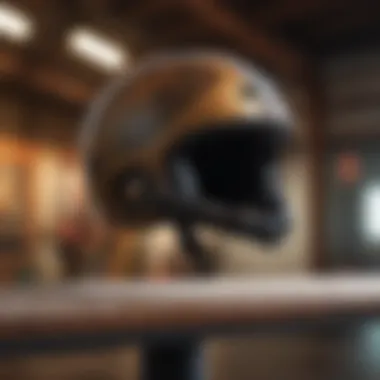The Ultimate Guide to Men's Skateboard Helmets


Intro
Skateboarding has long evolved from a simple pastime into a global phenomenon. As with any sport that involves some level of risk, understanding how to ensure one’s safety is paramount. A skateboard helmet serves not only as a protective gear but as a crucial element of responsible skating. This guide delves into the facets of skateboard helmets for men, stripping down the jargon to present clear insights.
The History of the Sport
Origin and Evolution
Skateboarding originated in the late 1940s in California when surfers sought something to do on land. Initially, wooden crates or planks were utilized, but they soon transformed into the boards we recognize today, equipped with wheels. Over the years, companies began producing specialized skateboards, making the sport more mainstream.
Milestones and Influences
As the 1970s unfolded, the first skate parks emerged, providing dedicated spaces for skaters. The invention of urethane wheels revolutionized everything, improving performance and allowing skaters to achieve greater speeds and tricks. By the 1980s, skateboarding had become a cultural phenomenon, prominently featuring in a variety of media, including television and films. The introduction of competitions further forced gear innovations.
Key Athletes and Pioneers
Athletes such as Tony Hawk and Rodney Mullen played pivotal roles in developing skateboarding techniques and popularizing the sport. They not only influenced the evolution of skateboarding tricks but also highlighted the importance of protective gear, thus gradually nudging the culture toward safety awareness.
Safety Measures
Essential Safety Gear
Wearing a helmet is not merely a suggestion; it is essential for safe skating. High-quality skateboard helmets are designed to protect the head during falls. They should meet safety standards like those from the CPSC or ASTM. Along with helmets, knee pads, elbow pads, and wrist guards help in minimizing injuries.
Safety Practices and Procedures
Establishing safe skating practices starts with knowing your limits. Always skate in designated areas, avoid crowded spaces, and remain aware of your surroundings. Consider wearing bright or reflective gear to enhance visibility. Practicing in an empty area can build confidence before attempting new tricks.
How to Prepare for Unexpected Situations
Always be prepared for the possibility of falls. Wearing the right gear and being mentally focused can mitigate risks. Additionally, consider having first-aid supplies handy, especially if skating in remote areas where assistance is not easily accessible.
Gear Recommendations
Top Brands and Products
Brands like Pro-Tec and Triple Eight are recognized for producing some of the best skate helmets available. Investing in a reliable helmet from a known brand increases the likelihood of adequate protection.
Budget vs.
Premium Options
Skateboard helmets are available in various price ranges. Budget options can provide sufficient safety for beginners, while premium helmets offer advanced features—like lightweight materials and better ventilation—that may benefit more experienced skaters.
Maintenance and Care for Gear
To elongate the life of your helmet, store it in a cool, dry place, away from direct sunlight. Regularly check for cracks and wear that could compromise safety. Clean the interior padding with mild soap and water to maintain hygiene.
Always prioritize buying a helmet that fits well. A helmet that does not fit properly is less effective in protecting you.
Prolusion to Skateboard Helmets
Skateboarding is an activity that combines creativity, skill, and elements of risk. The introduction of helmets to this sport represents a significant step towards safety, setting a tone for responsible practice. This section explores the importance of skateboard helmets and their relevance in today’s skating landscape.
Purpose of Skateboard Helmets
The primary purpose of skateboard helmets is to protect the head from injuries during falls or accidents. Impacts on the skull can lead to serious consequences. Studies show that wearing a helmet significantly decreases the risk of head injuries by nearly 70%. In a sport known for its tricks and high speeds, this protection is not merely optional; it is vital.
Skateboard helmets are designed to absorb force and mitigate the damage that could occur from an impact. They are typically made from materials like EPS foam, which provides effective cushioning. Additionally, many helmets now come equipped with features like built-in visors and removable liners for neck support and comfort. These added functions enhance usability and promote more frequent helmet use.
Skateboarding Trends and Safety
Skateboarding has evolved through the years, with diverse styles and techniques gaining popularity. Whether it’s street skating in urban environments or ramp skating in skate parks, safety has become an integral aspect of this culture.
Recent trends indicate a growing awareness surrounding safety gear in street culture. More skaters are not only adopting helmets but also promoting their value through social media channels. Videos showing accidents often lead to discussions about the necessity of protective gear. This shift creates a community that values safety just as much as creativity in skating.
Skateboarding brands also respond to this trend by producing not only stylish helmets but also gear that meets stringent safety standards. As the sport continues to gain traction, the influence of professional skaters advocating for helmet use cannot be overlooked. Their voices play a critical role in fostering an environment where safety is prioritized.


"Wearing a helmet is not just about safety; it’s about respect for the sport and oneself."
Understanding the Importance of Helmets
The role of helmets in skateboarding can't be overstated. Helmets serve as an essential barrier between the head and potential injuries from falls, collisions, or other unexpected incidents. They are not just a mere accessory; they are crucial safety equipment. Failing to wear a helmet can result in severe head injuries, some of which may have long-lasting consequences. By informing oneself about the significance of helmets, skateboarders can make safer decisions and reduce the risk associated with their sport.
Injury Prevention Statistics
Statistics demonstrate the gravity of not wearing helmets. Research indicates that about 70% of skateboard injuries affect the head. Furthermore, wearing a helmet can significantly reduce the likelihood of sustaining a traumatic brain injury. A study from the American Journal of Sports Medicine found that skaters who wore helmets were 85% less likely to suffer severe head injuries compared to those who did not. Here are a few compelling insights:
- Head injuries are among the most common: When a skateboarder falls, the head is often the first point of impact.
- Lifelong implications: Severe injuries can have a profound effect on quality of life.
- Cultural shift: There is an increasing awareness and acceptance of helmet use within the skateboarding community.
Ultimately, these statistics emphasize that using a helmet is not just a recommendation; it is a necessity for anyone who engages in this exhilarating sport.
Legal Requirements for Helmet Use
In many jurisdictions, wearing a helmet is more than a safety recommendation; it is a legal obligation. Various states and localities have enacted laws mandating helmet use for minors and, in some cases, adults. Understanding these legal requirements can help skateboarders avoid fines and, more importantly, serious injuries. Some key points to consider include:
- State specifics: Each state may have its own laws regarding helmet use, and knowing these can prevent mishaps.
- Penalties for non-compliance: Fines for failing to wear a helmet can range from warnings to monetary penalties.
- Insurance implications: In the event of an accident, not wearing a helmet may impact insurance claims.
Adhering to legal guidelines not only protects the individual but also promotes a responsible and safety-conscious culture within the skateboarding community.
Wearing a helmet is a simple step that can save lives.
Key Features of Men’s Skateboard Helmets
When choosing a skateboard helmet, understanding the key features is crucial for ensuring safety, comfort, and performance. The right helmet should provide adequate protection without compromising usability or style. The following sections will detail the essential elements that make up a men's skateboard helmet, highlighting their specific benefits and considerations.
Material Composition
The material of a skateboard helmet significantly affects its durability and protective capabilities. Most helmets are constructed using a combination of materials designed to absorb impact, such as expanded polystyrene (EPS) foam for the interior and outer shells made from polycarbonate or fiberglass.
- EPS is lightweight and has excellent shock absorption qualities, making it ideal for preventing head injuries during falls.
- A high-quality outer shell helps to withstand abrasions.
Choosing a helmet made from these materials improves the chances of sustained protection while also ensuring that the helmet is not too heavy. As a potential buyer, it is essential to check the specifications to ensure the materials meet safety standards.
Fit and Comfort
A helmet should fit snugly but comfortably on your head. Safety can be compromised with a loose or overly tight helmet. A proper fit can be assessed by following these guidelines:
- Position the helmet level on your head.
- Ensure that it sits about an inch above your eyebrows.
- There should not be any excessive movement.
Look for helmets with adjustable chin straps and padding. A good fit not only enhances safety but also makes the helmet more comfortable to wear for extended periods. Comfort can be a major factor in encouraging men to wear helmets consistently.
Ventilation Systems
Ventilation systems are vital for keeping the head cool during intense skateboarding sessions. Proper airflow can prevent overheating and allow for longer usage times.
- Helmets with larger vents can help regulate temperature and wick away sweat.
- Some brands have developed specialized ventilation designs that significantly reduce wind resistance.
Choosing a helmet with an effective ventilation system should not come at the cost of safety. The design must still meet or exceed safety standards while ensuring that airflow is maximized.
Weight Considerations
Weight is an often-overlooked feature in helmet selection. A heavier helmet may provide more protection, but it can also lead to fatigue during long use. Men should consider the following:
- Lightweight designs often incorporate advanced materials that do not sacrifice strength for weight.
- A helmet weighing around 400-600 grams can provide enough protection without being burdensome.
The balance of weight and protection is essential. A helmet that is too heavy can deter skaters from wearing it, increasing the risk of injury.
Remember: A skateboard helmet should feel like a natural extension of your head, not something that weighs you down or hinders movement.
By keeping these key features in mind—material composition, fit and comfort, ventilation systems, and weight—men can make informed decisions that align with their skating style while prioritizing safety and practicality.
Types of Skateboard Helmets
Understanding the various types of skateboard helmets is crucial for every rider. Each type of helmet offers unique benefits and considerations that cater to different skating styles and safety needs. Selecting the right helmet type enhances not only safety but also the overall skateboarding experience.


Multi-Sport Helmets
Multi-sport helmets are designed to meet the needs of athletes who engage in various activities beyond skateboarding. These helmets offer versatile protection suitable for biking, inline skating, and other extreme sports. The primary advantage of a multi-sport helmet is its adaptability. They typically feature a lightweight construction and ventilated designs keeping comfort in mind during extended use.
When choosing a multi-sport helmet, consider the following:
- Versatility: Great for those who switch between sports frequently.
- Comfort: Often equipped with soft liners and adjustable straps.
- Safety Ratings: Make sure it meets specific safety standards for each sport.
Half Shell Helmets
Half shell helmets offer coverage primarily for the top and back of the head, leaving the face exposed. They are favored in skateboarding for their lightweight feel and stylish appearance. Riders who prefer an unobstructed view while maneuvering may find these helmets advantageous.
Benefits of half shell helmets include:
- Style: They often come in various designs and colors, appealing to aesthetic preferences.
- Breathability: Open design allows for better air circulation, making them comfortable in warm conditions.
- Ease of Use: Simple design makes them easy to put on and take off.
However, they may not offer as much protection as other types, especially for extensive falls or accidents.
Full Face Helmets
Full face helmets provide the highest level of protection by covering the entire head, including the face. These helmets are increasingly popular among downhill riders and those performing high-risk tricks. Full face helmets not only safeguard against impacts but also shield against environmental elements.
Considerations for full face helmets include:
- Maximum Protection: Ideal for high-speed environments and when performing tricks.
- Enhanced Coverage: Protects your chin and jaw, areas that are often vulnerable during falls.
- Integrated Visors: Many models come with visors to shield eyes from debris.
In summary, understanding the types of skateboard helmets helps potential buyers make informed selections. Whether opting for the versatility of multi-sport helmets, the stylish appeal of half shell designs, or the serious protection of full face helmets, each type possesses attributes that uniquely cater to the varying demands of skateboarders.
Safety Standards and Certifications
Safety certifications are essential when it comes to skateboard helmets. They ensure that the products have been rigorously tested for quality and performance. Understanding these standards allows consumers to make informed choices and increases overall safety for skateboarders.
ASTM Standards
The ASTM (American Society for Testing and Materials) standards specifically apply to helmets used in various sports, including skateboarding. These guidelines establish minimum performance requirements. They cover aspects such as impact resistance, retention system effectiveness, and durability tests. Helmets labeled with ASTM certification provide assurance that they have passed critical testing procedures.
It is also worth noting that ASTM standards are regularly updated to reflect advancements in materials and technologies. This means that a helmet meeting these standards is likely to offer enhanced protection compared to older models.
CPSC Regulations
The CPSC (Consumer Product Safety Commission) regulations provide mandatory safety standards that all helmets sold in the United States must meet. These regulations focus on headgear's ability to reduce the risk of head injuries during an impact. Key requirements include:
- Impact energy management
- Penetration resistance
- Labeling requirements for proper usage
Choosing a helmet that adheres to CPSC regulations is critical. It ensures that you are wearing a product that has undergone extensive tests designed to keep you safe while you skate. Be sure to check for labels indicating compliance before making a purchase.
Additional Certifications
Beyond ASTM and CPSC, some helmets might also carry additional certifications that further demonstrate their safety. These can include certifications from organizations like Snell and EN 1078.
- Snell Certification - This is often seen in higher-end helmets and signifies rigorous testing beyond CPSC requirements.
- EN 1078 - This European standard affects import and sale of helmets in various countries, showing that a helmet meets international safety guidelines.
Ending on Certifications
With a plethora of options available, it is crucial to prioritize safety standards and certifications while choosing a skateboard helmet. Paying attention to these details not only enhances your protection but also promotes a culture of safety within the skateboarding community. Always look for reliable certifications; they can make a significant difference.
Maintenance and Care of Skateboard Helmets
Maintaining and caring for skateboard helmets is essential for ensuring their effectiveness in protecting the wearer. Regular upkeep extends the life of the helmet, ensuring it continues to provide the necessary safety features while also remaining comfortable to wear. Skaters should prioritize helmet care to reduce the risk of injuries that can occur when a helmet is compromised due to neglect.
Regular Cleaning Practices
Proper cleaning of your helmet is crucial. Dirt, dust, sweat, and grime can build up over time, potentially impairing both the comfort and protective qualities of the helmet.
- Surface Cleaning: Wipe down the exterior with a damp cloth to remove dirt after every use. Avoid harsh chemicals that can degrade the materials.
- Interior Maintenance: Remove any detachable liners and wash them according to the manufacturer's instructions. This helps to control odor and improve hygiene.
- Drying: Allow the helmet to air dry completely before using it again, especially if it has been washed. This prevents mold and unpleasant smells from developing.
Identifying Wear and Tear


Recognizing when a helmet has become worn is vital for safety. Signs of wear can indicate that the helmet is no longer capable of providing adequate protection. Common indicators include:
- Cracks: Inspect for any visible cracks or damage on the outer shell. Even small cracks can significantly weaken the helmet.
- Deteriorating Foam: Check the foam interior for any signs of compression or breaking down. If the foam appears compressed or feels less supportive, it might not absorb impacts correctly.
- Faded Colors: While not always indicative of performance issues, faded colors can suggest that the helmet has been exposed to excessive sun or wear.
If you notice any of these signs, it is recommended to replace your helmet immediately to ensure safety while skating.
Replacement Cycle for Helmets
Even with proper care, helmets have a finite lifespan. It is important to adhere to replacement guidelines to optimize their safety capabilities.
- General Recommendation: Most helmet manufacturers suggest replacing helmets every three to five years, depending on usage and exposure to elements.
- Post-Impact Check: Replace your helmet immediately after any significant impact, even if there are no visible signs of damage. The internal structure may be compromised.
- Consult Manufacturer Guidelines: Always refer to the specific recommendations provided by the manufacturer for replacement schedules and safety tips.
Maintaining, inspecting, and knowing when to replace your skateboard helmet is key to preventing injuries. Proper care ensures that the helmet remains reliable and effective in providing protection during rides.
Popular Skateboard Helmet Brands for Men
Choosing the right skateboard helmet can greatly impact both safety and performance. As the market offers a wide array of brands, it is necessary to understand which brands are reputable and cater specifically to the needs of skateboarders. This section discusses the significance of popular skateboard helmet brands and highlights what consumers should consider during their selection process.
Top-rated Brands Overview
When it comes to skateboard helmets, certain brands have gained recognition and trust among users. Here are some of the top-rated brands:
- Bell: Known for their innovative designs and safety features. They provide helmets with advanced technology to enhance protection.
- Pro-Tec: A pioneer in the skateboarding helmet market, Pro-Tec helmets are renowned for their comfort and durability.
- Thousand: They blend style with safety, featuring helmets that prioritize aesthetics while meeting safety standards.
- Kairoi: Offers helmets that provide excellent ventilation and a lightweight feel, essential for long sessions.
These brands have established a strong presence in the market by consistently prioritizing safety and user experience.
Budget-Friendly Options
Not everyone wants to splurge on a helmet, and thankfully, there are budget-friendly options that still meet safety standards.
- Triple Eight: They are known for providing affordable helmets that don't compromise on quality. Features adjustable straps for a comfortable fit.
- Razor: Their helmets are popular for being light and comfortable, suitable for casual skaters or beginners.
- Skate gr8: This brand offers various vibrant designs at a lower price point, catering to younger skaters.
These helmets help make protective gear accessible without sacrificing safety.
High-End Models
For serious skaters who prioritize the best protection and advanced features, high-end models provide additional benefits. Some notable options include:
- Giro: They provide high-end helmets equipped with advanced multi-directional impact protection systems, ideal for extreme environments.
- Troy Lee Designs: Often used in professional competitions, known for their exceptional fit and ventilation.
- Smith: Incorporates innovative material technology for maximum strength and weight savings, designed for those who demand the best.
Investing in these models often results in superior comfort and safety features, further enhancing the skating experience.
Choosing the Right Skateboard Helmet
Choosing the right skateboard helmet is essential for ensuring safety while riding. A well-chosen helmet goes beyond mere compliance with safety regulations; it adapts to personal needs, style preferences, and riding habits. As the popularity of skateboarding continues to grow, understanding the nuances of helmet selection becomes crucial for both new and seasoned skaters. With many options available, focusing on what constitutes a good fit, comfort, and protection is vital.
Assessing Personal Needs
When selecting a skateboard helmet, start by assessing your personal needs. Consider how you skate and where you skate. Do you mostly ride in parks, or do you prefer street skating? Different environments may require different levels of protection.
Next, factor in your comfort. Helmets that do not fit properly can cause discomfort, leading skaters to avoid wearing them altogether. Measure your head circumference to find the correct size. Look for helmets that offer adjustable straps and padding for a more tailored fit. Additionally, consider the weight of the helmet. A lightweight helmet encourages longer wear without fatigue.
Another aspect to consider is style. Helmets come in various designs, colors, and shapes. Aesthetics often matter to skaters, as they want to look good while prioritizing safety. Finding a balance between style and functionality is thus critical.
Comparative Buying Strategies
After identifying personal needs, the next step is to develop strategies for buying a skateboard helmet. First, research is crucial. This involves reading reviews, consulting forums, and visiting online spaces like Reddit or skateboard-specific groups on Facebook. Skater's experiences provide valuable insight into the effectiveness and comfort of different helmet brands.
Second, consider price versus features. This balance will help determine which helmets fit within your budget while still meeting your needs. Quality helmets may have a higher initial cost, but they often last longer and offer better protection.
- Create a shortlist of helmets based on personal preferences and needs.
- Compare features like ventilation, materials, and safety ratings between those helmets.
- If possible, visit a local shop to try helmets on, as personal fit is often best assessed in person.
Finally, keep an eye out for seasonal sales or promotions. Many brands offer discounts during certain times of the year, which can be a good opportunity to purchase a higher-end model at a reduced price.
Remember, investing in a good helmet is investing in your safety.
By conducting thorough research and assessing your needs, you can confidently choose a skateboard helmet that aligns with your style and safety requirements.
Closure
Final Thoughts on Safety
When considering a skateboard helmet, one must prioritize safety above all else. Skaters should recognize the potential dangers inherent in their favorite sport and commit to protecting themselves. Helmet usage can mean the difference between a minor fall and a life-altering injury. The importance of helmets extends beyond personal safety; it also encourages a culture of responsibility within the skateboarding community. Choosing a suitable helmet involves assessing comfort, fit, and adherence to recognized safety standards - all essential for a skater's peace of mind while they ride.
"Safety first ensures that we can continue to enjoy the thrill of skateboarding without the heavy cost of preventable injuries."
Therefore, the right helmet is a blend of protection, style, and comfort that supports the adventurous spirit of skateboarding while safeguarding skaters. Education around helmets, their maintenance, and the correct selection process enhances overall awareness and contributes to a sustainable skating culture.







